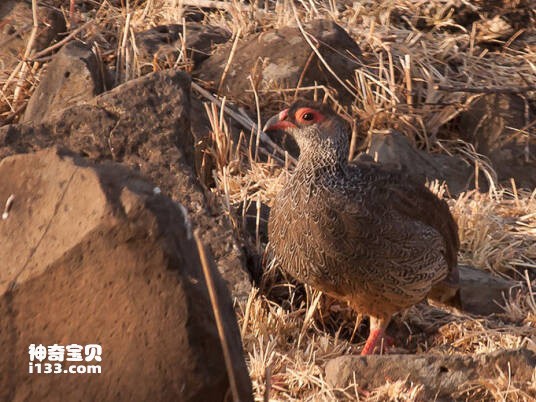Pternistis harwoodi
IUCN
LCBasic Information
Scientific classification
- name:Pternistis harwoodi
- Scientific Name:Pternistis harwoodi,Harwood's Francolin
- Outline:Landfowl
- Family:Chickeniformes Pheasants Polytridges
Vital signs
- length:33-35cm
- Weight:446-545g
- lifetime:No textual research information is available
Feature
The crown is brown, the upper jaw is black, but the tip and base are red
Distribution and Habitat
A species endemic to Ethiopia of central Ethiopia south of Lake Tana. The range covers a very limited area extending 160 kilometers along the Nile and its tributaries. The southern and eastern parts of its known range suggest that the species may not be as rare as previously thought.
The habitat was chosen in areas where cattails grew in streams at the bottom of the canyon. Usually alternated with some sparse trees, troublesome bushes, abandoned or poorly maintained crop areas, and sparse woodlands within mountain areas.
Appearance
The partridge is 33-35 cm long; The male weighs 545 grams and the female 446 grams. The upper jaw is black, but the tip and base are red. Red jaw. The exposed skin around the eyes has a large red area. Legs and claws red. The sexes are the same, but the male has 2 distances and the female has only one or none. The adult male has a dark brown crown, black forehead and eyebrows, and gray ears. The sides of the neck near the head are white with thin black stripes. The neck and chest have a yellowish tint, with many black "U" shaped marks that extend to the flank and abdomen. The abdomen has a distinctive light yellow color. The upper part is grayish brown with a faint vermiculite color and inconspicuous flashing streaks. The feathers are grayish-brown with a pale yellow vermiculite color. The plumage of the female bird is very similar to that of the male bird, but the underbody is mostly light brown, and the pattern decorating the abdomen is more like a "U" shape than
Details
Hai's colored partridge (scientific name: Pternistis harwoodi) foreign name Harwood' s Francolin, no subspecies.

The survival of this species is considered vulnerable. Apparently, it's not as rare as people think, and in the 1990s, it was found in a number of places, but it wasn't thought to be found. Nevertheless, the extremely small distribution area exposes the species to many dangers, including hunting and the presence of humans.
Listed on the International Union for Conservation of Nature (IUCN) 2016 Red List of Threatened Species ver 3.1 - Not Threatened (LC).
Protect wild animals and eliminate wild meat.
Maintaining ecological balance is everyone's responsibility!








